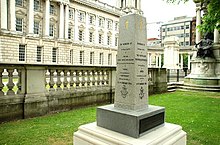Royal Ulster Rifles
[20] In 1937 the already close relationship with the London Irish Rifles was formally recognised when they were incorporated into the Corps while still retaining their regimental identity as a territorial battalion.[21] When war was declared the 1st Battalion was serving in India, with the 31st Independent Brigade Group, which was trained in mountain warfare.[23] Carried in Horsa gliders, the battalion took part in Operation Mallard, the British glider-borne landings in the later afternoon of 6 June 1944, otherwise known as D-Day.200 Group National Defence Companies and consisting of older men with previous military experience who were unfit for active service.[11] The 1st Battalion, Royal Ulster Rifles disembarked at Pusan in early November 1950 as part of the 29th Independent Infantry Brigade Group for service in the Korean War.As the New Year started, the Fiftieth Chinese Communist Army engaged the United Nations troops focusing on 29 Brigade, who were dispersed over a very wide front (12 miles).With virtually no cover and seriously outnumbered, the Royal Ulster Rifles came under heavy fire as they withdrew to a blocking position.The Brigade was able to hold its position, despite fierce fighting, and neutralized the effectiveness of the Sixty-fourth Chinese Communist Army.[34] It stood overlooking the battlefield until 1962 when Seoul's growth threatened to consume it, and it was carried by HMS Belfast back to Ireland where it was the focus of St Patrick's Barracks in Ballymena.[33] When the barracks closed in 2008, the Imjin River Memorial was again moved, this time to the grounds of the Belfast City Hall.[35] The Regiment continued to accept recruits from the rest of Ireland; for example, almost 50% of personnel in the 1st Battalion who arrived in Korea in 1950 were Irish nationals.The museum's artefacts include uniforms, badges, medals, regimental memorabilia, trophies, paintings and photographs.





Kingdom of Great BritainUnited KingdomBritish ArmyRiflesLight infantryRegularMilitiaSpecial ReserveVictoria Barracks, BelfastSt Patrick's BarracksBallymenaQuis SeparabitBadajozJhansiinfantryrifle regiment83rd (County of Dublin) Regiment of Foot86th (Royal County Down) Regiment of FootSecond Boer WarFirst World WarSecond World WarKorean WarNorth Irish BrigadeRoyal Irish Fusiliers (Princess Victoria's)Royal Inniskilling FusiliersRoyal Irish RangersBelfast City HallKing George IIIFrench First RepublicChilders ReformsIrelandPhoenix ParkDublinWar OfficeBattle of StormbergmemorialLord GrenfellTerritorial ForceBattle of the Somme1st Battalion Royal Irish Rifles in World War ILe Havre25th Brigade8th DivisionWestern FrontBattle of Neuve ChapelleBattle of FromellesBattle of Loos7th Brigade3rd DivisionBattle of MonsBattle of Le CateauFirst Battle of the MarneFirst Battle of the AisneBattle of La BasséeBattle of MessinespioneerAnzac Cove29th Brigade10th (Irish) DivisionSalonikaPalestineRoyal Jersey Militia48th Brigade16th (Irish) DivisionJames SteeleBoulogne-sur-Mer107th Brigade36th (Ulster) Division108th Brigade109th Brigade1938 al-Bassa MassacreLondon Irish RiflesAirspeed Horsa31st Independent Brigade Groupglider-borneBorder RegimentSouth Staffs2nd Ox and Bucks1st Airlanding Brigadeglider infantry1st Airborne Divisionairborne forcesDevonshire Regiment6th Airlanding Brigade6th Airborne DivisionBritish Army in World War IIHorsa glidersOperation MallardBattle of Normandyadvanced 45 miles in 9 dayssurprise German offensive in the ArdennesOperation VarsityOperation Plunder21st Army GroupU.S. 17th Airborne DivisionSir Bernard Montgomery9th Infantry Brigade3rd Infantry DivisionBritish Expeditionary ForceMajor GeneralBernard MontgomeryNorth West Europe CampaignBattle of Dunkirkevacuated from DunkirkD-Day landingsOperation Charnwoodbitter fightingNational Defence Companies215th Independent Infantry Brigade (Home)8th Battalion, Royal Ulster Rifles203rd Independent Infantry Brigade (Home)Royal Artillery117th Light Anti-Aircraft Regiment, Royal ArtilleryNorth African CampaignBritish First Armyinitial invasionBritish Eighth ArmyItalian FrontRifle Brigade (Prince Consort's Own)61st Lorried Infantry Brigade6th Armoured DivisionconscriptionRoyal Irish Fusiliers29th Independent Infantry Brigade GroupUijeongbuEighth United States Army